A Comprehensive Report on VAT Regulations and Compliance in Finance
VerifiedAdded on 2020/12/18
|16
|4419
|216
Report
AI Summary
This report provides a comprehensive overview of Value Added Tax (VAT) regulations, focusing on compliance, reporting, and the implications for businesses. It begins with an introduction to indirect taxes and specifically VAT, explaining its core concept as a tax on the value added to goods and services. The main body delves into understanding VAT regulations, including sources of information like the UK government's HMRC website and publications, and details the interactions between organizations and relevant government agencies. It outlines VAT registration requirements, the information required on business documentation for VAT-registered businesses, the requirements and frequency of reporting for various VAT schemes (annual, cash, flat rate, and standard), and the importance of maintaining knowledge of changes in codes of practice, regulations, and legislation. The report then discusses completing VAT returns accurately and in a timely manner, covering data extraction from accounting systems, calculation of inputs and outputs, calculation of VAT due, and the completion and submission of returns within statutory time limits. It also addresses understanding VAT penalties and making adjustments for previous errors, including implications for non-compliance and procedures for correcting errors. Finally, the report touches on communicating VAT information, specifically informing managers about the impact of VAT payments on cash flows and advising relevant people of changes in VAT legislation's effects on organization's recording system. The report concludes by summarizing the key aspects of VAT regulations and compliance. References to books and journals are also included.

Indirect Tax
Paraphrase This Document
Need a fresh take? Get an instant paraphrase of this document with our AI Paraphraser
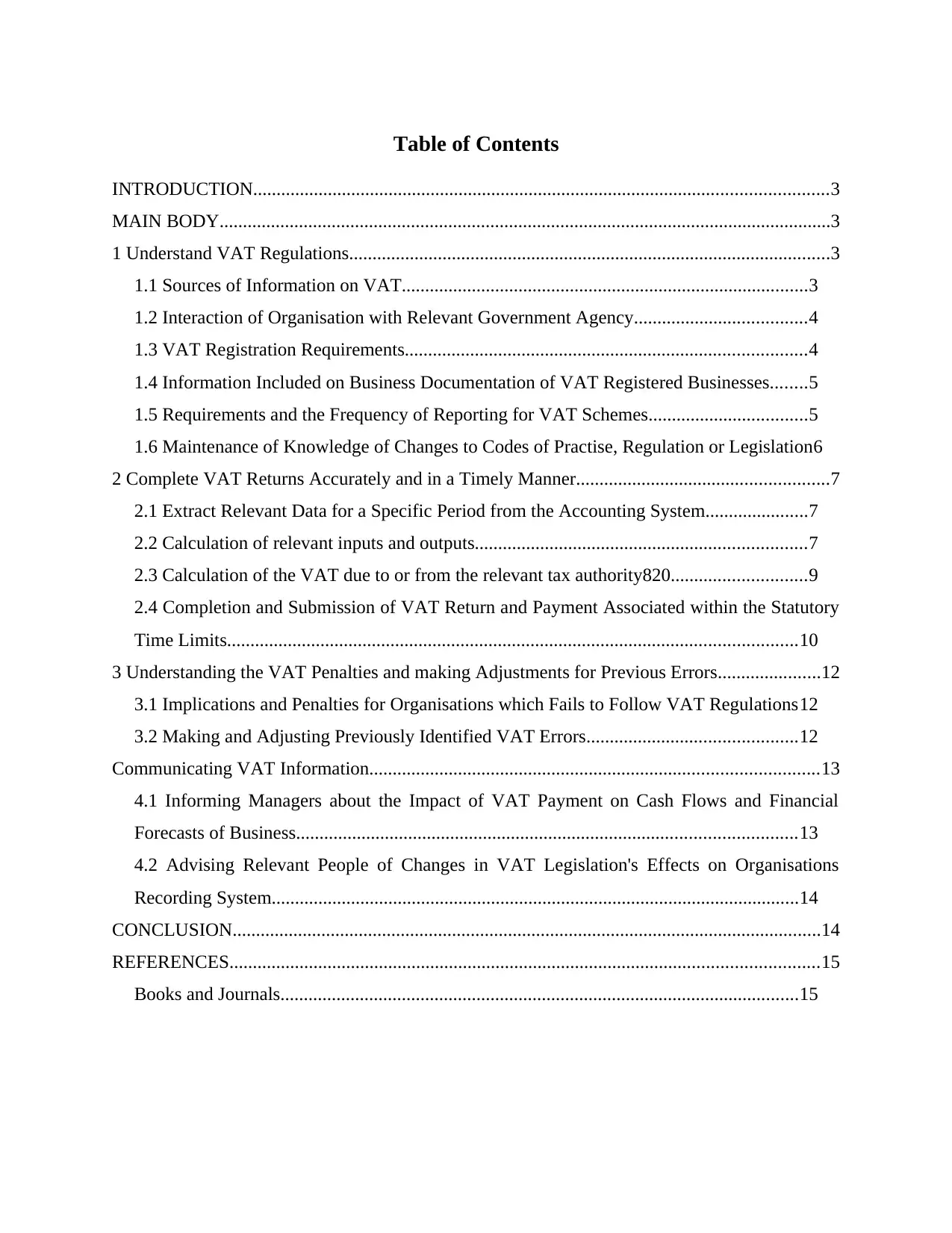
Table of Contents
INTRODUCTION...........................................................................................................................3
MAIN BODY...................................................................................................................................3
1 Understand VAT Regulations.......................................................................................................3
1.1 Sources of Information on VAT.......................................................................................3
1.2 Interaction of Organisation with Relevant Government Agency.....................................4
1.3 VAT Registration Requirements......................................................................................4
1.4 Information Included on Business Documentation of VAT Registered Businesses........5
1.5 Requirements and the Frequency of Reporting for VAT Schemes..................................5
1.6 Maintenance of Knowledge of Changes to Codes of Practise, Regulation or Legislation6
2 Complete VAT Returns Accurately and in a Timely Manner......................................................7
2.1 Extract Relevant Data for a Specific Period from the Accounting System......................7
2.2 Calculation of relevant inputs and outputs.......................................................................7
2.3 Calculation of the VAT due to or from the relevant tax authority820.............................9
2.4 Completion and Submission of VAT Return and Payment Associated within the Statutory
Time Limits..........................................................................................................................10
3 Understanding the VAT Penalties and making Adjustments for Previous Errors......................12
3.1 Implications and Penalties for Organisations which Fails to Follow VAT Regulations12
3.2 Making and Adjusting Previously Identified VAT Errors.............................................12
Communicating VAT Information................................................................................................13
4.1 Informing Managers about the Impact of VAT Payment on Cash Flows and Financial
Forecasts of Business...........................................................................................................13
4.2 Advising Relevant People of Changes in VAT Legislation's Effects on Organisations
Recording System.................................................................................................................14
CONCLUSION..............................................................................................................................14
REFERENCES..............................................................................................................................15
Books and Journals...............................................................................................................15
INTRODUCTION...........................................................................................................................3
MAIN BODY...................................................................................................................................3
1 Understand VAT Regulations.......................................................................................................3
1.1 Sources of Information on VAT.......................................................................................3
1.2 Interaction of Organisation with Relevant Government Agency.....................................4
1.3 VAT Registration Requirements......................................................................................4
1.4 Information Included on Business Documentation of VAT Registered Businesses........5
1.5 Requirements and the Frequency of Reporting for VAT Schemes..................................5
1.6 Maintenance of Knowledge of Changes to Codes of Practise, Regulation or Legislation6
2 Complete VAT Returns Accurately and in a Timely Manner......................................................7
2.1 Extract Relevant Data for a Specific Period from the Accounting System......................7
2.2 Calculation of relevant inputs and outputs.......................................................................7
2.3 Calculation of the VAT due to or from the relevant tax authority820.............................9
2.4 Completion and Submission of VAT Return and Payment Associated within the Statutory
Time Limits..........................................................................................................................10
3 Understanding the VAT Penalties and making Adjustments for Previous Errors......................12
3.1 Implications and Penalties for Organisations which Fails to Follow VAT Regulations12
3.2 Making and Adjusting Previously Identified VAT Errors.............................................12
Communicating VAT Information................................................................................................13
4.1 Informing Managers about the Impact of VAT Payment on Cash Flows and Financial
Forecasts of Business...........................................................................................................13
4.2 Advising Relevant People of Changes in VAT Legislation's Effects on Organisations
Recording System.................................................................................................................14
CONCLUSION..............................................................................................................................14
REFERENCES..............................................................................................................................15
Books and Journals...............................................................................................................15
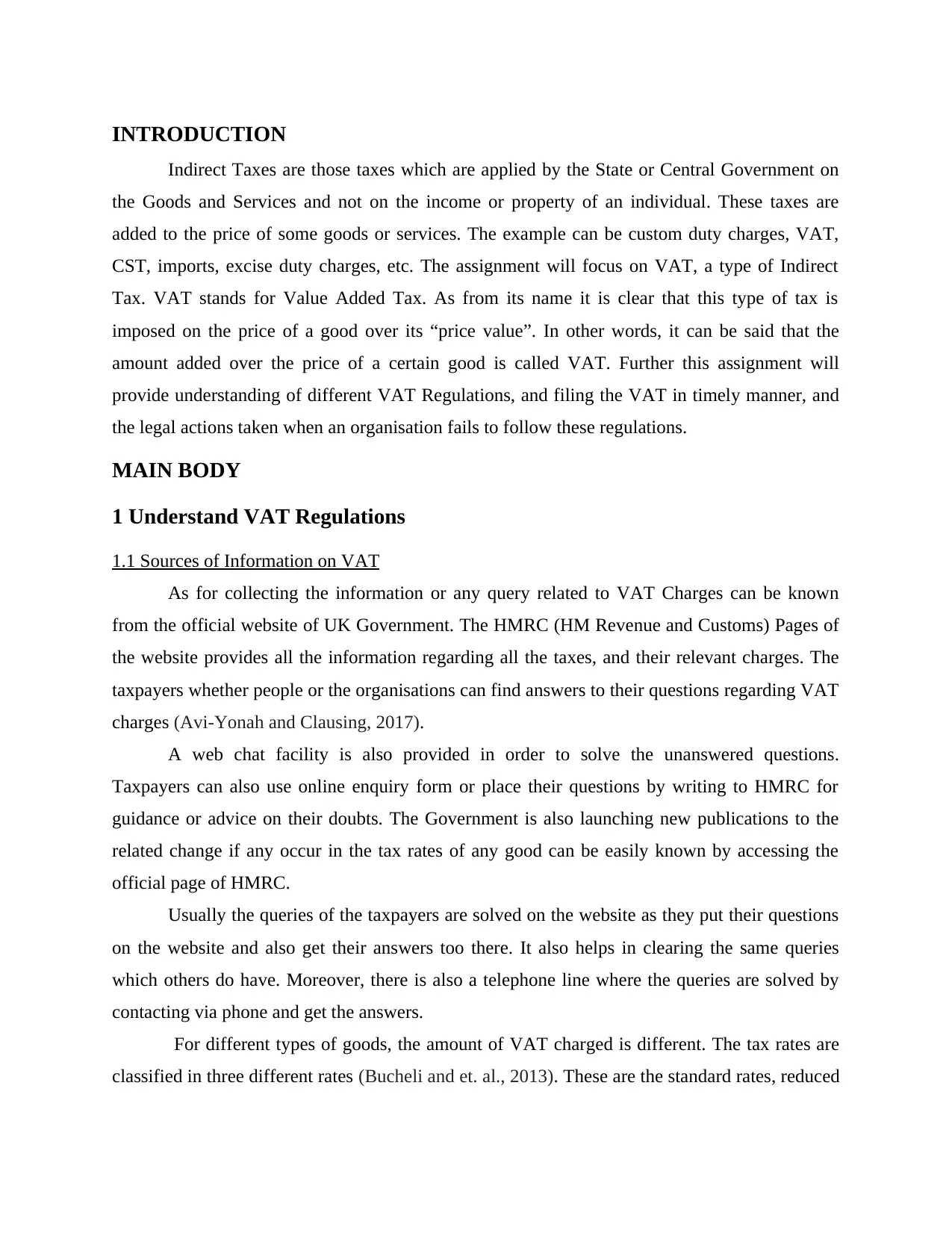
INTRODUCTION
Indirect Taxes are those taxes which are applied by the State or Central Government on
the Goods and Services and not on the income or property of an individual. These taxes are
added to the price of some goods or services. The example can be custom duty charges, VAT,
CST, imports, excise duty charges, etc. The assignment will focus on VAT, a type of Indirect
Tax. VAT stands for Value Added Tax. As from its name it is clear that this type of tax is
imposed on the price of a good over its “price value”. In other words, it can be said that the
amount added over the price of a certain good is called VAT. Further this assignment will
provide understanding of different VAT Regulations, and filing the VAT in timely manner, and
the legal actions taken when an organisation fails to follow these regulations.
MAIN BODY
1 Understand VAT Regulations
1.1 Sources of Information on VAT
As for collecting the information or any query related to VAT Charges can be known
from the official website of UK Government. The HMRC (HM Revenue and Customs) Pages of
the website provides all the information regarding all the taxes, and their relevant charges. The
taxpayers whether people or the organisations can find answers to their questions regarding VAT
charges (Avi-Yonah and Clausing, 2017).
A web chat facility is also provided in order to solve the unanswered questions.
Taxpayers can also use online enquiry form or place their questions by writing to HMRC for
guidance or advice on their doubts. The Government is also launching new publications to the
related change if any occur in the tax rates of any good can be easily known by accessing the
official page of HMRC.
Usually the queries of the taxpayers are solved on the website as they put their questions
on the website and also get their answers too there. It also helps in clearing the same queries
which others do have. Moreover, there is also a telephone line where the queries are solved by
contacting via phone and get the answers.
For different types of goods, the amount of VAT charged is different. The tax rates are
classified in three different rates (Bucheli and et. al., 2013). These are the standard rates, reduced
Indirect Taxes are those taxes which are applied by the State or Central Government on
the Goods and Services and not on the income or property of an individual. These taxes are
added to the price of some goods or services. The example can be custom duty charges, VAT,
CST, imports, excise duty charges, etc. The assignment will focus on VAT, a type of Indirect
Tax. VAT stands for Value Added Tax. As from its name it is clear that this type of tax is
imposed on the price of a good over its “price value”. In other words, it can be said that the
amount added over the price of a certain good is called VAT. Further this assignment will
provide understanding of different VAT Regulations, and filing the VAT in timely manner, and
the legal actions taken when an organisation fails to follow these regulations.
MAIN BODY
1 Understand VAT Regulations
1.1 Sources of Information on VAT
As for collecting the information or any query related to VAT Charges can be known
from the official website of UK Government. The HMRC (HM Revenue and Customs) Pages of
the website provides all the information regarding all the taxes, and their relevant charges. The
taxpayers whether people or the organisations can find answers to their questions regarding VAT
charges (Avi-Yonah and Clausing, 2017).
A web chat facility is also provided in order to solve the unanswered questions.
Taxpayers can also use online enquiry form or place their questions by writing to HMRC for
guidance or advice on their doubts. The Government is also launching new publications to the
related change if any occur in the tax rates of any good can be easily known by accessing the
official page of HMRC.
Usually the queries of the taxpayers are solved on the website as they put their questions
on the website and also get their answers too there. It also helps in clearing the same queries
which others do have. Moreover, there is also a telephone line where the queries are solved by
contacting via phone and get the answers.
For different types of goods, the amount of VAT charged is different. The tax rates are
classified in three different rates (Bucheli and et. al., 2013). These are the standard rates, reduced
⊘ This is a preview!⊘
Do you want full access?
Subscribe today to unlock all pages.

Trusted by 1+ million students worldwide
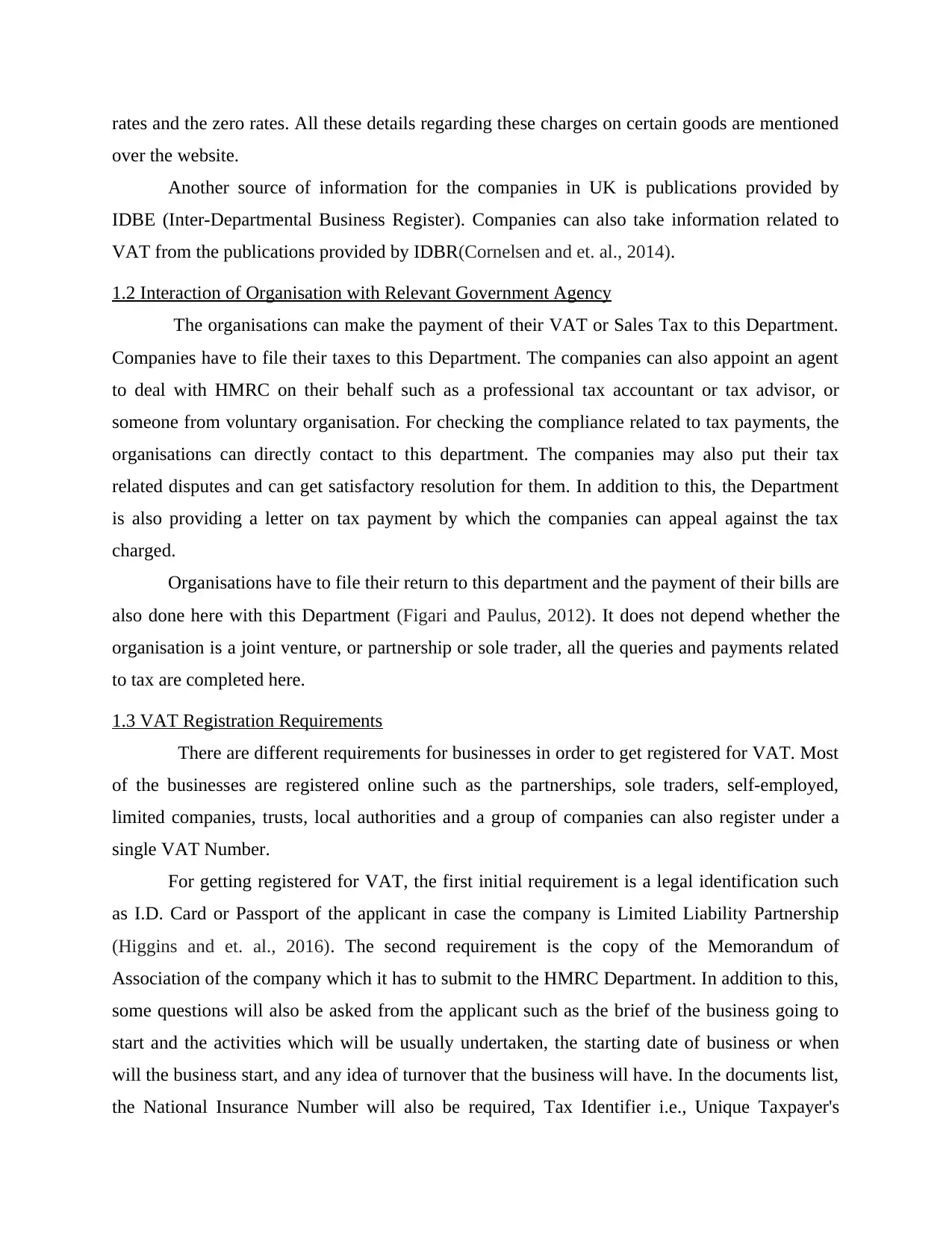
rates and the zero rates. All these details regarding these charges on certain goods are mentioned
over the website.
Another source of information for the companies in UK is publications provided by
IDBE (Inter-Departmental Business Register). Companies can also take information related to
VAT from the publications provided by IDBR(Cornelsen and et. al., 2014).
1.2 Interaction of Organisation with Relevant Government Agency
The organisations can make the payment of their VAT or Sales Tax to this Department.
Companies have to file their taxes to this Department. The companies can also appoint an agent
to deal with HMRC on their behalf such as a professional tax accountant or tax advisor, or
someone from voluntary organisation. For checking the compliance related to tax payments, the
organisations can directly contact to this department. The companies may also put their tax
related disputes and can get satisfactory resolution for them. In addition to this, the Department
is also providing a letter on tax payment by which the companies can appeal against the tax
charged.
Organisations have to file their return to this department and the payment of their bills are
also done here with this Department (Figari and Paulus, 2012). It does not depend whether the
organisation is a joint venture, or partnership or sole trader, all the queries and payments related
to tax are completed here.
1.3 VAT Registration Requirements
There are different requirements for businesses in order to get registered for VAT. Most
of the businesses are registered online such as the partnerships, sole traders, self-employed,
limited companies, trusts, local authorities and a group of companies can also register under a
single VAT Number.
For getting registered for VAT, the first initial requirement is a legal identification such
as I.D. Card or Passport of the applicant in case the company is Limited Liability Partnership
(Higgins and et. al., 2016). The second requirement is the copy of the Memorandum of
Association of the company which it has to submit to the HMRC Department. In addition to this,
some questions will also be asked from the applicant such as the brief of the business going to
start and the activities which will be usually undertaken, the starting date of business or when
will the business start, and any idea of turnover that the business will have. In the documents list,
the National Insurance Number will also be required, Tax Identifier i.e., Unique Taxpayer's
over the website.
Another source of information for the companies in UK is publications provided by
IDBE (Inter-Departmental Business Register). Companies can also take information related to
VAT from the publications provided by IDBR(Cornelsen and et. al., 2014).
1.2 Interaction of Organisation with Relevant Government Agency
The organisations can make the payment of their VAT or Sales Tax to this Department.
Companies have to file their taxes to this Department. The companies can also appoint an agent
to deal with HMRC on their behalf such as a professional tax accountant or tax advisor, or
someone from voluntary organisation. For checking the compliance related to tax payments, the
organisations can directly contact to this department. The companies may also put their tax
related disputes and can get satisfactory resolution for them. In addition to this, the Department
is also providing a letter on tax payment by which the companies can appeal against the tax
charged.
Organisations have to file their return to this department and the payment of their bills are
also done here with this Department (Figari and Paulus, 2012). It does not depend whether the
organisation is a joint venture, or partnership or sole trader, all the queries and payments related
to tax are completed here.
1.3 VAT Registration Requirements
There are different requirements for businesses in order to get registered for VAT. Most
of the businesses are registered online such as the partnerships, sole traders, self-employed,
limited companies, trusts, local authorities and a group of companies can also register under a
single VAT Number.
For getting registered for VAT, the first initial requirement is a legal identification such
as I.D. Card or Passport of the applicant in case the company is Limited Liability Partnership
(Higgins and et. al., 2016). The second requirement is the copy of the Memorandum of
Association of the company which it has to submit to the HMRC Department. In addition to this,
some questions will also be asked from the applicant such as the brief of the business going to
start and the activities which will be usually undertaken, the starting date of business or when
will the business start, and any idea of turnover that the business will have. In the documents list,
the National Insurance Number will also be required, Tax Identifier i.e., Unique Taxpayer's
Paraphrase This Document
Need a fresh take? Get an instant paraphrase of this document with our AI Paraphraser

Reference Number (UTR), Certificate of Incorporation, Business Bank Account Details all these
are required and must be provided in front of the Department in order to get registered. Further,
in case the business is already established, the applicant must provide all the information of the
business for the past two years. A business must be registered having a turnover to be more than
of £85,000 within a period of next 30 days. There are also some exemptions where there is no
need to register for VAT so it is necessary to register VAT only in case the business is to sell
goods and services (Jaramillo Baanante, 2013).
1.4 Information Included on Business Documentation of VAT Registered Businesses
The information which are included on the Business Documentation of a business are as
follow as:
Date of Commencement: The Date when the business was started or will start is to be
provided to the Department.
Expected Turnover; The applicant must tell the current turnover or the expected turnover
of the business in case the business is newly established.
Address of Business: The complete address where the business will be situated or is
situated is to be provided to HRMC.
Contact Details: The mobile number, email address and the website of the business
should be provided for getting registered.
Full Shareholder Listing and Holding: The name and number of shareholders of the
company should also be stated during the registration(Kaplanoglou, 2015).
Full Names of Director/Secretary: If the company is a Limited Company than it is a must
to provide the full name of the secretary and director of the company.
Description of the Business; In order to get registered, the information about the business
activity that it is going to carry on should be mentioned.
1.5 Requirements and the Frequency of Reporting for VAT Schemes
Annual Accounting Scheme; Generally, the businesses registered under VAT fill their
returns and payments 4 times during a year to HMRC. The Annual Accounting Scheme
provides businesses to pay their annual bills in quarterly or on monthly basis, but they
have to submit only one VAT Return per year. In accordance to this scheme, a VAT
Registered business must submit a VAT Return four times per year(VAT Annual
Accounting Scheme, 2018). For making these advance payments of VAT Bill, the
are required and must be provided in front of the Department in order to get registered. Further,
in case the business is already established, the applicant must provide all the information of the
business for the past two years. A business must be registered having a turnover to be more than
of £85,000 within a period of next 30 days. There are also some exemptions where there is no
need to register for VAT so it is necessary to register VAT only in case the business is to sell
goods and services (Jaramillo Baanante, 2013).
1.4 Information Included on Business Documentation of VAT Registered Businesses
The information which are included on the Business Documentation of a business are as
follow as:
Date of Commencement: The Date when the business was started or will start is to be
provided to the Department.
Expected Turnover; The applicant must tell the current turnover or the expected turnover
of the business in case the business is newly established.
Address of Business: The complete address where the business will be situated or is
situated is to be provided to HRMC.
Contact Details: The mobile number, email address and the website of the business
should be provided for getting registered.
Full Shareholder Listing and Holding: The name and number of shareholders of the
company should also be stated during the registration(Kaplanoglou, 2015).
Full Names of Director/Secretary: If the company is a Limited Company than it is a must
to provide the full name of the secretary and director of the company.
Description of the Business; In order to get registered, the information about the business
activity that it is going to carry on should be mentioned.
1.5 Requirements and the Frequency of Reporting for VAT Schemes
Annual Accounting Scheme; Generally, the businesses registered under VAT fill their
returns and payments 4 times during a year to HMRC. The Annual Accounting Scheme
provides businesses to pay their annual bills in quarterly or on monthly basis, but they
have to submit only one VAT Return per year. In accordance to this scheme, a VAT
Registered business must submit a VAT Return four times per year(VAT Annual
Accounting Scheme, 2018). For making these advance payments of VAT Bill, the

estimation is made through the payment of last bill and the amount is settled at the end of
year whether the difference is paid by the business or it can apply for Refund in case
more amount is paid.
Cash Accounting Scheme: The Cash Accounting VAT Scheme is a method in which the
VAT is recorded on the basis of payment made and received. For getting registered under
this VAT Scheme, the business must have a turnover of equals to or less than £1.35
Million. The frequency of submitting VAT in this method is four times a year.
Flat Rate Accounting Scheme: The Scheme is also known as VAT FRS. Under this
scheme, VAT is paid by the business as a fixed percentage of its annual turnover and the
amount is paid quarterly to HMRC. The scheme was mainly introduced for the small
businesses to reduce the burden imposed while operating through VAT. The requirement
is to be registered under VAT and must have a turnover of under £ 150,000.
Standard Accounting Scheme: Under this method of reporting VAT, a business records
and pays VAT when it issues invoices whether for purchase or sale. The companies
registered under this scheme submit their VAT Return four times a year. Both the
outstanding and refunds of the companies will be settled on quarterly basis (Lustig and
Higgins, 2013). The requirement to register under this scheme is that the turnover of the
company must be above £1,350,000.
1.6 Maintenance of Knowledge of Changes to Codes of Practise, Regulation or Legislation
Every business wants to avoid the government intervention in its business operations. In
this case of VAT submission, a business must be aware and up-to-date about the changes made
by HMRC in filing the VAT Return and any alteration or addition in the existing laws by HMRC
should properly taken into consideration by the business. It will help in smooth running of their
business and will help in avoiding unwanted fines or penalties. The business should maintain
proper business records and files of return so that the business working can be accomplished
without any problem (Lustig and et. al., 2012). Proper knowledge of Codes of Practise will make
business to run according to the changes made by the Department. It will also enhance the
relationship between the stakeholders and the company. The stakeholders of company will be
satisfied as the image of company is clear in the market. It will also enhance the Brand Image of
the company as there will no difference in the records and the actual working of the company.
The company's accounts are reflecting the same as they are saying. These changes in the
year whether the difference is paid by the business or it can apply for Refund in case
more amount is paid.
Cash Accounting Scheme: The Cash Accounting VAT Scheme is a method in which the
VAT is recorded on the basis of payment made and received. For getting registered under
this VAT Scheme, the business must have a turnover of equals to or less than £1.35
Million. The frequency of submitting VAT in this method is four times a year.
Flat Rate Accounting Scheme: The Scheme is also known as VAT FRS. Under this
scheme, VAT is paid by the business as a fixed percentage of its annual turnover and the
amount is paid quarterly to HMRC. The scheme was mainly introduced for the small
businesses to reduce the burden imposed while operating through VAT. The requirement
is to be registered under VAT and must have a turnover of under £ 150,000.
Standard Accounting Scheme: Under this method of reporting VAT, a business records
and pays VAT when it issues invoices whether for purchase or sale. The companies
registered under this scheme submit their VAT Return four times a year. Both the
outstanding and refunds of the companies will be settled on quarterly basis (Lustig and
Higgins, 2013). The requirement to register under this scheme is that the turnover of the
company must be above £1,350,000.
1.6 Maintenance of Knowledge of Changes to Codes of Practise, Regulation or Legislation
Every business wants to avoid the government intervention in its business operations. In
this case of VAT submission, a business must be aware and up-to-date about the changes made
by HMRC in filing the VAT Return and any alteration or addition in the existing laws by HMRC
should properly taken into consideration by the business. It will help in smooth running of their
business and will help in avoiding unwanted fines or penalties. The business should maintain
proper business records and files of return so that the business working can be accomplished
without any problem (Lustig and et. al., 2012). Proper knowledge of Codes of Practise will make
business to run according to the changes made by the Department. It will also enhance the
relationship between the stakeholders and the company. The stakeholders of company will be
satisfied as the image of company is clear in the market. It will also enhance the Brand Image of
the company as there will no difference in the records and the actual working of the company.
The company's accounts are reflecting the same as they are saying. These changes in the
⊘ This is a preview!⊘
Do you want full access?
Subscribe today to unlock all pages.

Trusted by 1+ million students worldwide
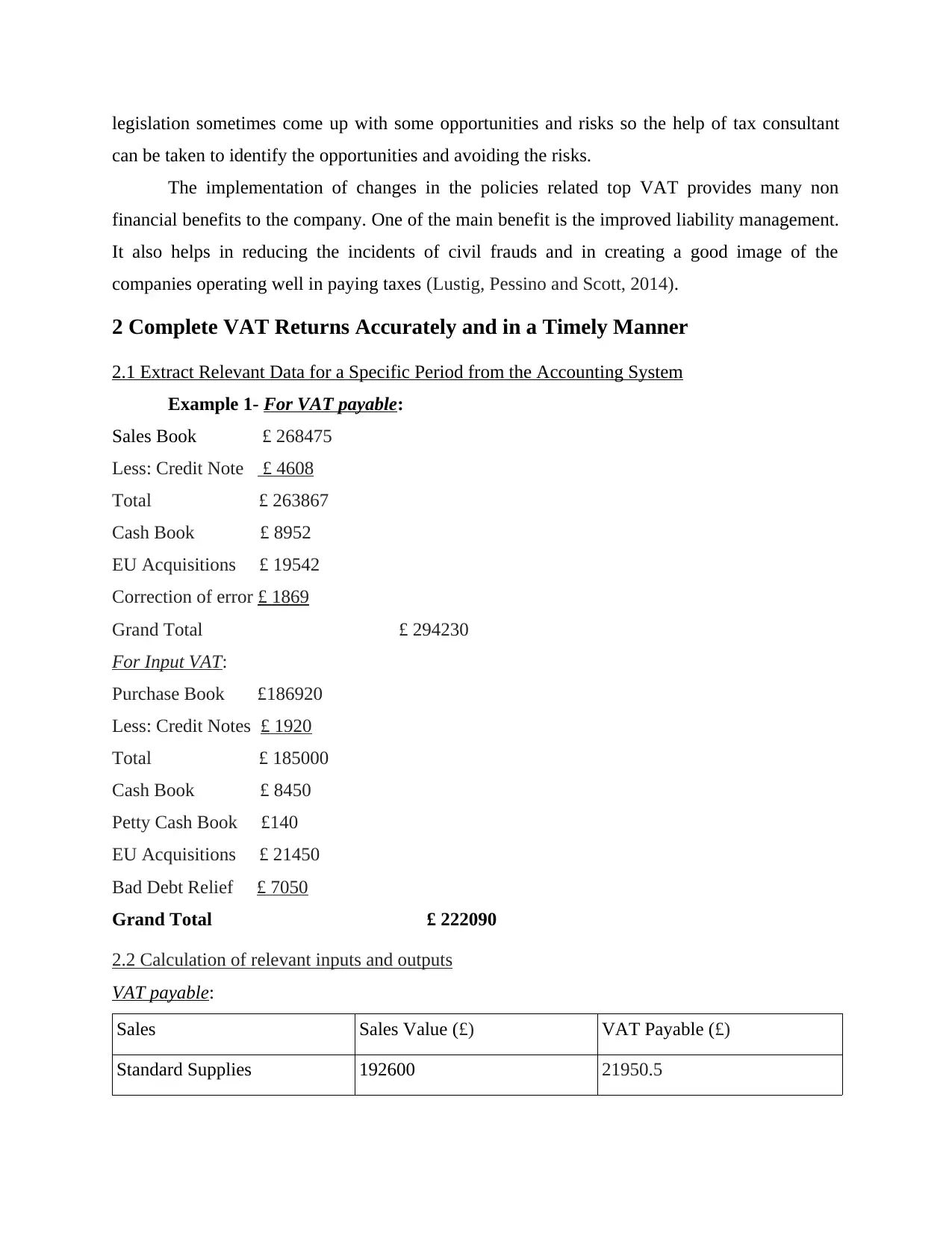
legislation sometimes come up with some opportunities and risks so the help of tax consultant
can be taken to identify the opportunities and avoiding the risks.
The implementation of changes in the policies related top VAT provides many non
financial benefits to the company. One of the main benefit is the improved liability management.
It also helps in reducing the incidents of civil frauds and in creating a good image of the
companies operating well in paying taxes (Lustig, Pessino and Scott, 2014).
2 Complete VAT Returns Accurately and in a Timely Manner
2.1 Extract Relevant Data for a Specific Period from the Accounting System
Example 1- For VAT payable:
Sales Book £ 268475
Less: Credit Note £ 4608
Total £ 263867
Cash Book £ 8952
EU Acquisitions £ 19542
Correction of error £ 1869
Grand Total £ 294230
For Input VAT:
Purchase Book £186920
Less: Credit Notes £ 1920
Total £ 185000
Cash Book £ 8450
Petty Cash Book £140
EU Acquisitions £ 21450
Bad Debt Relief £ 7050
Grand Total £ 222090
2.2 Calculation of relevant inputs and outputs
VAT payable:
Sales Sales Value (£) VAT Payable (£)
Standard Supplies 192600 21950.5
can be taken to identify the opportunities and avoiding the risks.
The implementation of changes in the policies related top VAT provides many non
financial benefits to the company. One of the main benefit is the improved liability management.
It also helps in reducing the incidents of civil frauds and in creating a good image of the
companies operating well in paying taxes (Lustig, Pessino and Scott, 2014).
2 Complete VAT Returns Accurately and in a Timely Manner
2.1 Extract Relevant Data for a Specific Period from the Accounting System
Example 1- For VAT payable:
Sales Book £ 268475
Less: Credit Note £ 4608
Total £ 263867
Cash Book £ 8952
EU Acquisitions £ 19542
Correction of error £ 1869
Grand Total £ 294230
For Input VAT:
Purchase Book £186920
Less: Credit Notes £ 1920
Total £ 185000
Cash Book £ 8450
Petty Cash Book £140
EU Acquisitions £ 21450
Bad Debt Relief £ 7050
Grand Total £ 222090
2.2 Calculation of relevant inputs and outputs
VAT payable:
Sales Sales Value (£) VAT Payable (£)
Standard Supplies 192600 21950.5
Paraphrase This Document
Need a fresh take? Get an instant paraphrase of this document with our AI Paraphraser
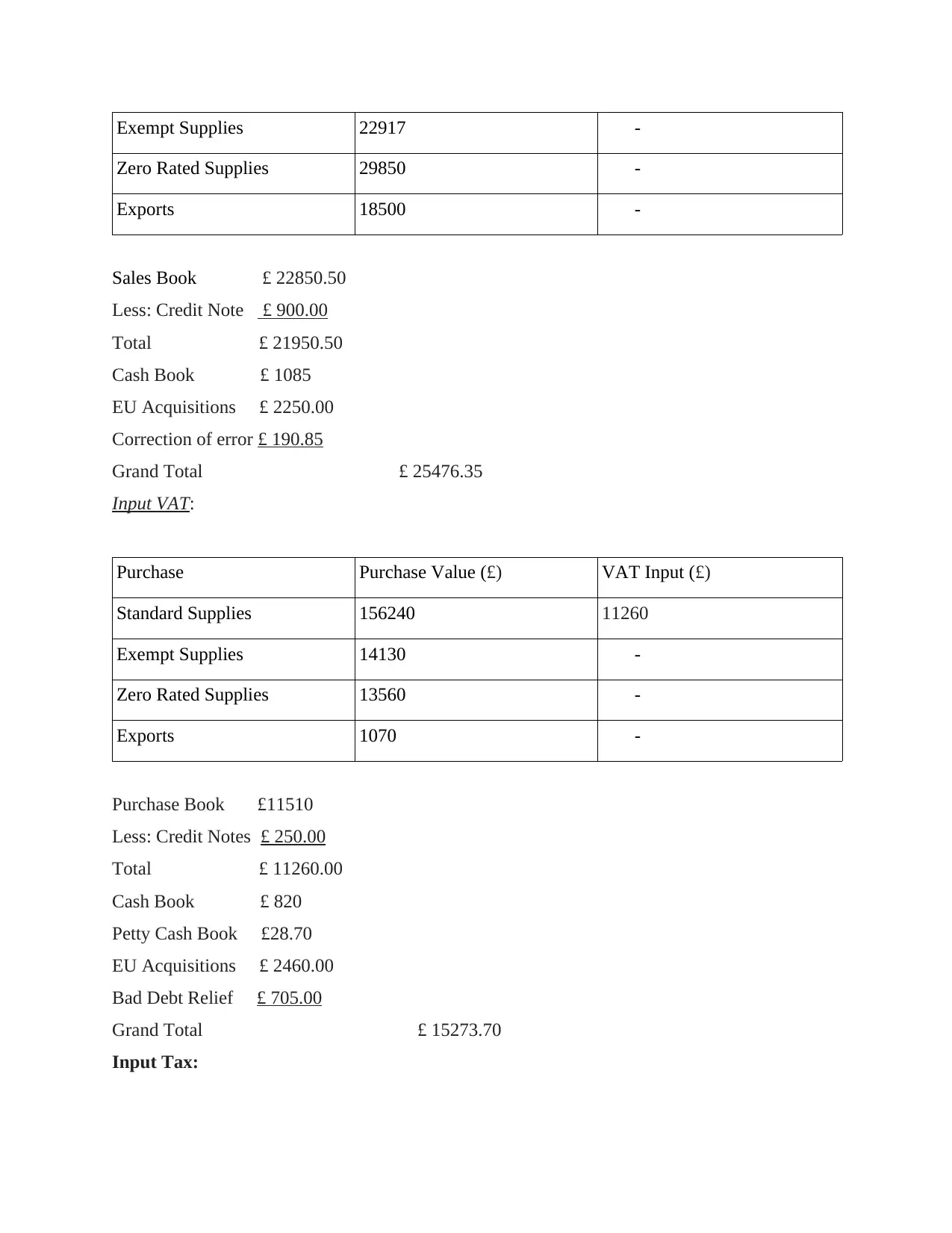
Exempt Supplies 22917 -
Zero Rated Supplies 29850 -
Exports 18500 -
Sales Book £ 22850.50
Less: Credit Note £ 900.00
Total £ 21950.50
Cash Book £ 1085
EU Acquisitions £ 2250.00
Correction of error £ 190.85
Grand Total £ 25476.35
Input VAT:
Purchase Purchase Value (£) VAT Input (£)
Standard Supplies 156240 11260
Exempt Supplies 14130 -
Zero Rated Supplies 13560 -
Exports 1070 -
Purchase Book £11510
Less: Credit Notes £ 250.00
Total £ 11260.00
Cash Book £ 820
Petty Cash Book £28.70
EU Acquisitions £ 2460.00
Bad Debt Relief £ 705.00
Grand Total £ 15273.70
Input Tax:
Zero Rated Supplies 29850 -
Exports 18500 -
Sales Book £ 22850.50
Less: Credit Note £ 900.00
Total £ 21950.50
Cash Book £ 1085
EU Acquisitions £ 2250.00
Correction of error £ 190.85
Grand Total £ 25476.35
Input VAT:
Purchase Purchase Value (£) VAT Input (£)
Standard Supplies 156240 11260
Exempt Supplies 14130 -
Zero Rated Supplies 13560 -
Exports 1070 -
Purchase Book £11510
Less: Credit Notes £ 250.00
Total £ 11260.00
Cash Book £ 820
Petty Cash Book £28.70
EU Acquisitions £ 2460.00
Bad Debt Relief £ 705.00
Grand Total £ 15273.70
Input Tax:
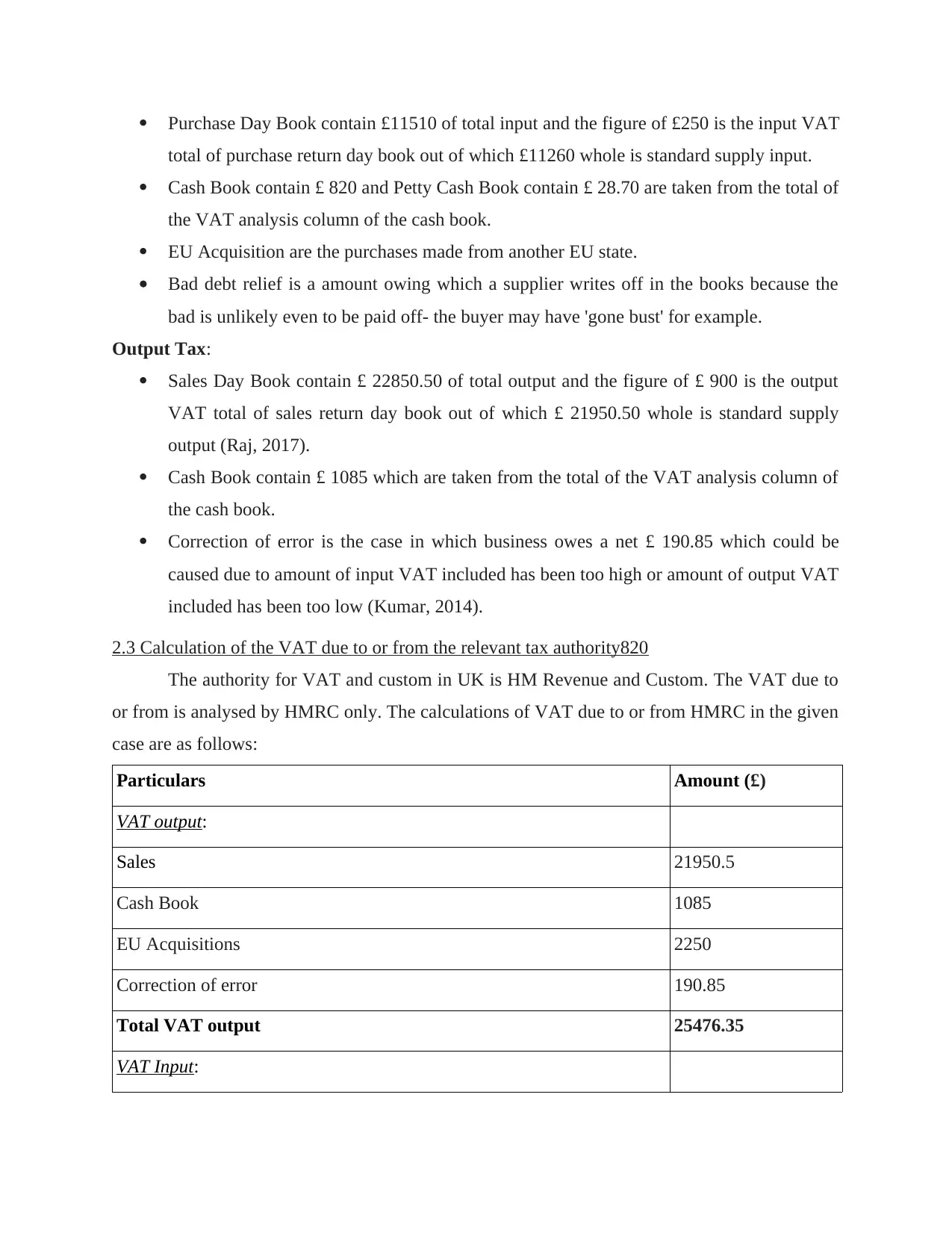
Purchase Day Book contain £11510 of total input and the figure of £250 is the input VAT
total of purchase return day book out of which £11260 whole is standard supply input.
Cash Book contain £ 820 and Petty Cash Book contain £ 28.70 are taken from the total of
the VAT analysis column of the cash book.
EU Acquisition are the purchases made from another EU state.
Bad debt relief is a amount owing which a supplier writes off in the books because the
bad is unlikely even to be paid off- the buyer may have 'gone bust' for example.
Output Tax:
Sales Day Book contain £ 22850.50 of total output and the figure of £ 900 is the output
VAT total of sales return day book out of which £ 21950.50 whole is standard supply
output (Raj, 2017).
Cash Book contain £ 1085 which are taken from the total of the VAT analysis column of
the cash book.
Correction of error is the case in which business owes a net £ 190.85 which could be
caused due to amount of input VAT included has been too high or amount of output VAT
included has been too low (Kumar, 2014).
2.3 Calculation of the VAT due to or from the relevant tax authority820
The authority for VAT and custom in UK is HM Revenue and Custom. The VAT due to
or from is analysed by HMRC only. The calculations of VAT due to or from HMRC in the given
case are as follows:
Particulars Amount (£)
VAT output:
Sales 21950.5
Cash Book 1085
EU Acquisitions 2250
Correction of error 190.85
Total VAT output 25476.35
VAT Input:
total of purchase return day book out of which £11260 whole is standard supply input.
Cash Book contain £ 820 and Petty Cash Book contain £ 28.70 are taken from the total of
the VAT analysis column of the cash book.
EU Acquisition are the purchases made from another EU state.
Bad debt relief is a amount owing which a supplier writes off in the books because the
bad is unlikely even to be paid off- the buyer may have 'gone bust' for example.
Output Tax:
Sales Day Book contain £ 22850.50 of total output and the figure of £ 900 is the output
VAT total of sales return day book out of which £ 21950.50 whole is standard supply
output (Raj, 2017).
Cash Book contain £ 1085 which are taken from the total of the VAT analysis column of
the cash book.
Correction of error is the case in which business owes a net £ 190.85 which could be
caused due to amount of input VAT included has been too high or amount of output VAT
included has been too low (Kumar, 2014).
2.3 Calculation of the VAT due to or from the relevant tax authority820
The authority for VAT and custom in UK is HM Revenue and Custom. The VAT due to
or from is analysed by HMRC only. The calculations of VAT due to or from HMRC in the given
case are as follows:
Particulars Amount (£)
VAT output:
Sales 21950.5
Cash Book 1085
EU Acquisitions 2250
Correction of error 190.85
Total VAT output 25476.35
VAT Input:
⊘ This is a preview!⊘
Do you want full access?
Subscribe today to unlock all pages.

Trusted by 1+ million students worldwide
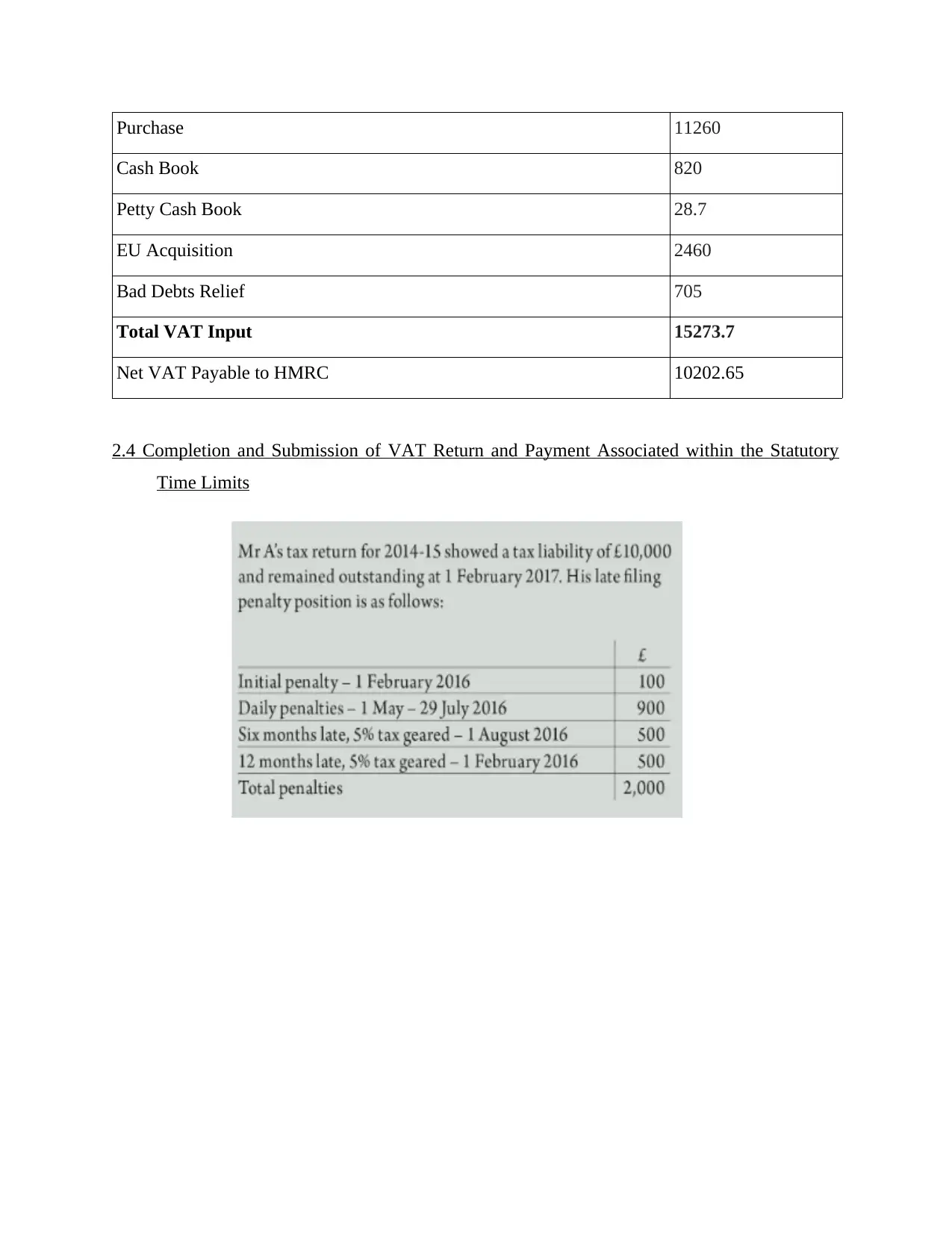
Purchase 11260
Cash Book 820
Petty Cash Book 28.7
EU Acquisition 2460
Bad Debts Relief 705
Total VAT Input 15273.7
Net VAT Payable to HMRC 10202.65
2.4 Completion and Submission of VAT Return and Payment Associated within the Statutory
Time Limits
Cash Book 820
Petty Cash Book 28.7
EU Acquisition 2460
Bad Debts Relief 705
Total VAT Input 15273.7
Net VAT Payable to HMRC 10202.65
2.4 Completion and Submission of VAT Return and Payment Associated within the Statutory
Time Limits
Paraphrase This Document
Need a fresh take? Get an instant paraphrase of this document with our AI Paraphraser
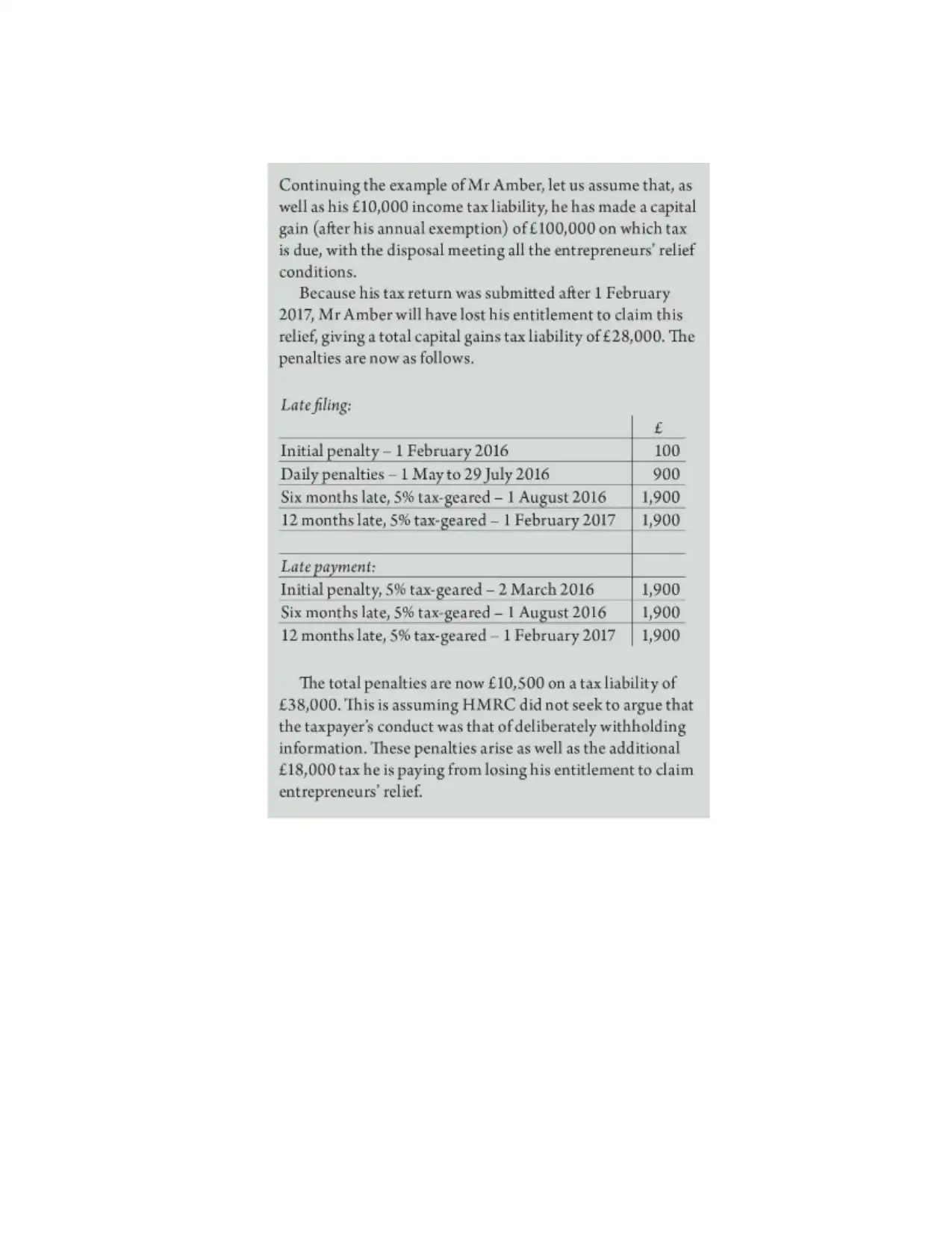

3 Understanding the VAT Penalties and making Adjustments for Previous
Errors
3.1 Implications and Penalties for Organisations which Fails to Follow VAT Regulations
The HMRC Department charges different penalties for different types of failures by the
organisations. It penalises the company in case it is unauthorised to issue invoices or is not
registered for VAT and the amount depends upon the disclosure or non disclosure of the fact
about the wrongdoing. The tax rates will increase if the company is not filing their return on
time. Additional Costs will be incurred by the company in case of breach of the legislations
(Mason and Stephenson Jr, 2017). The businesses registered under VAT may face harsh
penalties if any incorrect import data is recorded in the books and the penalty charged can be £
500 for each such misrepresentation of records. It will be charged even if the company is not
involved in any kind of fraudulent activity ever before.
In case when business is going on without approval from HMRC, it will be liable for
criminal conviction and penalty which can be of £ 10,000. Every business can apply before 30th
June of every year in case if the business is of fulfilment business which is started before 1st
April of the same year. The Department can charge a penalty of £ 500 if the business is not
applying for registration before the due date provided by them.
After registering business for VAT, it is the duty of business to make ensure that it is
following the rules and guidelines of VAT in a timely and correct manner. For not following
rules and laws of VAT, the business will be liable to pay surcharge of 2% of the outstanding tax
of the previous year, in case the annual turnover of the company is equal to or less than £
150.000(VAT Returns, 2018).
3.2 Making and Adjusting Previously Identified VAT Errors
Under Section 4, VAT Errors which are made deliberately and carelessly will be liable to
pat the penalty. However, HMRC is also providing grounds to companies for covering their
errors(Correcting VAT errors on a return already submitted, 2018).
In case business find out errors in their VAT records, then they have to inform HMRC
and follow the guidelines mentioned in Section 4 so that corrections can be made (Mills and et.
al., 2012). The help of tax advisor can be taken in order to remove the errors in VAT records.
Errors
3.1 Implications and Penalties for Organisations which Fails to Follow VAT Regulations
The HMRC Department charges different penalties for different types of failures by the
organisations. It penalises the company in case it is unauthorised to issue invoices or is not
registered for VAT and the amount depends upon the disclosure or non disclosure of the fact
about the wrongdoing. The tax rates will increase if the company is not filing their return on
time. Additional Costs will be incurred by the company in case of breach of the legislations
(Mason and Stephenson Jr, 2017). The businesses registered under VAT may face harsh
penalties if any incorrect import data is recorded in the books and the penalty charged can be £
500 for each such misrepresentation of records. It will be charged even if the company is not
involved in any kind of fraudulent activity ever before.
In case when business is going on without approval from HMRC, it will be liable for
criminal conviction and penalty which can be of £ 10,000. Every business can apply before 30th
June of every year in case if the business is of fulfilment business which is started before 1st
April of the same year. The Department can charge a penalty of £ 500 if the business is not
applying for registration before the due date provided by them.
After registering business for VAT, it is the duty of business to make ensure that it is
following the rules and guidelines of VAT in a timely and correct manner. For not following
rules and laws of VAT, the business will be liable to pay surcharge of 2% of the outstanding tax
of the previous year, in case the annual turnover of the company is equal to or less than £
150.000(VAT Returns, 2018).
3.2 Making and Adjusting Previously Identified VAT Errors
Under Section 4, VAT Errors which are made deliberately and carelessly will be liable to
pat the penalty. However, HMRC is also providing grounds to companies for covering their
errors(Correcting VAT errors on a return already submitted, 2018).
In case business find out errors in their VAT records, then they have to inform HMRC
and follow the guidelines mentioned in Section 4 so that corrections can be made (Mills and et.
al., 2012). The help of tax advisor can be taken in order to remove the errors in VAT records.
⊘ This is a preview!⊘
Do you want full access?
Subscribe today to unlock all pages.

Trusted by 1+ million students worldwide
1 out of 16
Related Documents
Your All-in-One AI-Powered Toolkit for Academic Success.
+13062052269
info@desklib.com
Available 24*7 on WhatsApp / Email
![[object Object]](/_next/static/media/star-bottom.7253800d.svg)
Unlock your academic potential
Copyright © 2020–2025 A2Z Services. All Rights Reserved. Developed and managed by ZUCOL.





